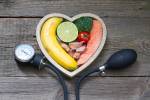Fridge too close at your home office? Steps to curb food cravings.
Your new office includes a makeshift desk, your laptop, a television and maybe a couch for a seat. Perhaps your fridge is almost within arm’s length, but certainly only a few steps away.
Now going into its third month for many Las Vegas stay-at-home workers, the COVID-19 pandemic may have brought on another potential health issue — controlling food cravings.
Psychological hunger is when you fancy something to eat. This is when you have a craving.
“Cravings can lead to a preoccupation with food,” says James Collier, head of nutrition at Huel, a nutrition company. “We want food, especially ‘bad’ foods, more than we did before. When we restrict ourselves from eating the foods we desire, it can have a bad effect on our mood. This increases temptation and when you then eat something you’re craving, you enjoy it even more. This can cause a negative cycle of mood changes that leads you to want to snack more, and then you recognize the intense pleasure next time you have a craving. Cravings become harder to curb.”
Food triggers
The trap continues. Just thinking about food triggers the behavior you want to avoid, i.e. eating. It’s especially hard as food is constantly around us, especially as we are spending more time than ever at home.
It’s such an important part of our social lives. We see advertisements for tasty foods everywhere, and it’s frequently the topic of conversation. None of this is helped when you’re always around family and they may be snacking around you when you’re trying not to think about food. Harder still, we often use food as a reward. We treat ourselves, and junk food is a frequent reward of choice.
How to curb cravings
The nutrition team at Huel put together a list of practical tips to help you curb your cravings. As you take control of your cravings, you’ll realize that you don’t actually need the food that you’re craving, it’s just a mindset. The frequency, duration and intensity of the cravings will diminish.
— Eat regular meals and stick to a schedule: Get into the habit of not skipping meals even if you are trying to be ‘good’ or because you feel guilty about what you ate earlier.
— Listen to your body: Eat regularly and only when you are genuinely hungry. Learn the difference between physiological and psychological hunger.
— Identify what’s causing your cravings: Keep a food and feelings diary by jotting down what you eat and when, and how you feel before and afterwards. This may help you identify triggers and problem times of the day, and to recognize if you’re snacking for comfort, boredom or loneliness.
— Find a hobby or interest: If you are snacking for comfort, eating will not make the problem go away. Do something to occupy yourself to avoid nibbling. Try chatting with a friend, exercising, watching a movie, or having a relaxing bath.
— Make eating a separate activity: Many people snack while doing certain things, and consequently, the activity then becomes a signal for a craving. For example: watching TV and snacking or eating popcorn at the movies. To curb this, only eat at mealtimes, get out of the habit of eating while watching TV and when at home, confine eating to the kitchen or dining room.
— Have regular drinks: This will help to keep you feeling full. Hot drinks are particularly useful as hot liquids empty from the stomach slower than cooler ones. Occasional sugar-free sodas can also help to satisfy your taste buds.
— If you get the urge to eat: Look at the time and wait half an hour before having something.
— Brush your teeth or use minty mouthwash after meals: The minty taste will help curb cravings. This is especially useful after your evening meal, as we often associate cleaning our teeth with the last thing we do with our mouth for the day.
— Adopt an eating strategy to help with discipline and to maintain a routine: For example, some people find intermittent fasting useful as it minimizes the window for permitted eating.
— Snack sensibly: Fruits and berries are a great choice and will help curb sweet cravings. Sugar-free Jell-O is also a great snack.
— Don’t let a slip-up lead to more: If you do succumb to a craving, avoid the mindset “now that I’ve eaten that, I may as well make the most of it.”
Plant-based diet tips
Collier has also put together some easy tips to make sure that people on a plant-based diet get the protein and vitamins they need:
— Eat a variety of foods: Especially different colored foods as these contain different levels of nutrients. For example, the phytonutrient lycopene, which is an antioxidant that protects against cell damage and gives tomatoes their red color. Other carotenoids also act as antioxidants and give fruits and vegetables their orange and yellow colors; for example, carrots.
— Vitamin B12 plays a vital role in helping the body produce red blood cells: It is perceived as tricky to get enough B12 with a plant-based diet. The good news is it need not be. As a start, try incorporating plant-based milks that are that are fortified with B12, as well as calcium and vitamin D. Cereals, meat alternatives, and some soy products are often fortified with B12 too. Taking a B12 supplement also rids any concerns.
— Ensure adequate omega-3 consumption: If oily fish is not part of your eating plan, then foods such as walnuts, soy products and flaxseed are ways to obtain a good intake of omega-3s. Omega-3 fats are generally low in a Western diet and adequate omega-3 consumption is crucial to support cardiovascular health.
— Keep your intake of iron up: Iron is not just found in meat food sources. Dark leafy greens, nuts and dried fruits are great sources of iron. Iron is crucial for oxygen transport, cognitive function, and the immune system. Iron from plant sources can be harder to absorb, but absorption can also be increased by the presence of vitamin C, which is found in lots of fruits and vegetables such as oranges and peppers. This is where the idea of having orange juice with breakfast comes from – to increase the absorption of iron that is in breakfast cereals.
— Protein-rich foods available to a plant-based diet: Some people claim plant-based proteins - beans, lentils, soy products, hummus, nuts, and seeds - are inferior to meat, eggs and dairy proteins, which isn’t the case. Although the amino acid profile of a single plant-based protein source may be inferior to an animal protein, this is easy to get around simply by combining more than one source of plant protein in a meal. For example, beans and rice both contain good amounts of protein.
Contact Marvin Clemons at mclemons@reviewjournal.com. Follow @Marv_in_Vegas on Twitter.

















































